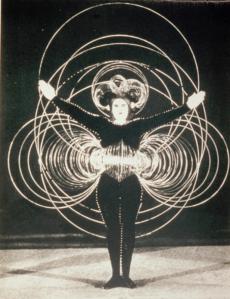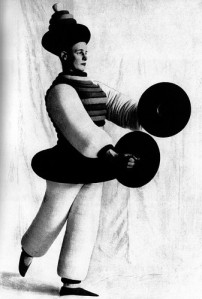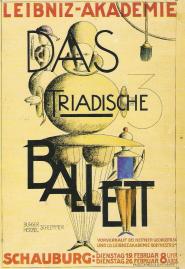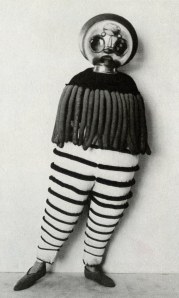Oskar Schlemmer was a German artist born in 1888 and later became an important figure in the Bauhaus movement. He was a painter, sculptor, designer and choreographer; his dance works were incredibly inventive and original with his token kooky sculptural costumes that altered the human physique entirely into the most fascinating of geometric shapes. He is most well-known for his piece The Triadic Ballet (or Das Triadische Ballett) which premiered in 1922. Divided into the three sections and with only three performers, the structure of The Triadic Ballet is as beautifully outlined as its outlandish costumes. The body and its movement become abstracted in a simple and incredibly complex manner.
 In this piece one feels the choreography is almost certainly secondary to the actual creations that the dancers are wearing. They are more than costumes, they are bizarre sculptural extensions of the body that both add and subtract certain qualities to the body. Oskar Schlemmer’s designs somehow manage to emphasize the natural body that lurks beneath, whilst at the same time they delineate and divert completely from the familiar and organic human body, creating a completely new and alien movement, shape and line. I find this is interesting. It is always interesting, adding things onto the body, stripping things away from the body; both can limit and/or enable movement or stillness allowing for endless questions and explorations regarding the human body.
In this piece one feels the choreography is almost certainly secondary to the actual creations that the dancers are wearing. They are more than costumes, they are bizarre sculptural extensions of the body that both add and subtract certain qualities to the body. Oskar Schlemmer’s designs somehow manage to emphasize the natural body that lurks beneath, whilst at the same time they delineate and divert completely from the familiar and organic human body, creating a completely new and alien movement, shape and line. I find this is interesting. It is always interesting, adding things onto the body, stripping things away from the body; both can limit and/or enable movement or stillness allowing for endless questions and explorations regarding the human body.
It was in America that I discovered sculpture was the next best thing to dance. I was in the Hirshhorn Sculpture Garden in Washington D.C. and it dawned on me that not only do sculpture and dance share a three-dimensional quality but sculptures actually move, too. I was slowly walking around some famous sculpture that I can’t even remember the name of and I was watching bits of it disappear, reappear, change, grow. I realized that my movement, my rotation of the work was causing it to do its own stationary sort of looped dance. Later on in my trip, when I was lucky enough to spend a day at Storm King Art Center outside New York City, I could only confirm that sculpture had to be the most engaging and responsive (and my personal favourite) of the non-performing arts.
Oskar Schlemmer’s iconic and historical dance works merge these two artforms in the most satisfying way possible. I am curious to find out or hear of a modern day choreographer approaching sculpture, dance, movement and design in a similar way to the ingenuity of Schlemmer’s approach. Anyway, enough of my blathering, the pictures are infinitely more interesting.






That last picture is not from The Triadic Ballet but is so super groovy that I decided to put it in there. Also, you can watch a full reconstruction of the piece that was done in 1970 and I think it is pretty good. It’s available on YouTube or on Vimeo (https://vimeo.com/28583474). Enjoy!
